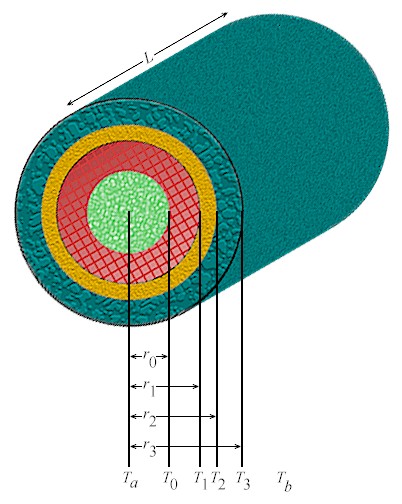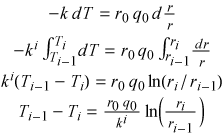Heat Conduction Through
Composite Cylindrical Walls:
CENG 402 Project
This page created by Dave Smith 4/25/99.
Email question/comments to dsmith@rice.edu.
Introduction
Problem Description
Defining Parameters
and Variables
The Shell Energy
Balance
Solving the Energy
Balance
Calculating Q0
= q0 A0
Introduction
This page discusses and solves the problem of heat conduction through a
cylindrical pipe insulated with several layers of mateials, each of a different thickness
and with a different thermal conductivity. This problem is also discussed as Example 9.6-1
of Transport Phenomena by Bird, Stewart, and Lightfoot.
Note: all of the work shown in the problem solution below was
evaluated in Mathematica. To download the complete Mathematica notebook
created for this problem, click on ceng402_ex9.6-1.nb.
Problem
Description
 In
industry, the most common method used to transport fluids between units and around the
plant is to pump the fluid through a cylindrical pipe. In most cases, it is desired to
keep the fluid at some temperature either above or below the ambient air temperature.
Hence, to minimize heat flux into or out of the pipe, the pipe is covered with insulation.
The insulation may be composed of several different layers, each layer having a different
thicknesses and a different thermal conductivity. Given (a) the temperature of the fluid
inside the pipe, (b) the ambient temperature outside, (c) information about the thickness
and thermal conductivity of each layer of insulation, and (d) the heat transfer
coefficients at the fluid-pipe and insulation-air interfaces, derive an expression for the
heat flux per unit length of pipe across the pipe.
In
industry, the most common method used to transport fluids between units and around the
plant is to pump the fluid through a cylindrical pipe. In most cases, it is desired to
keep the fluid at some temperature either above or below the ambient air temperature.
Hence, to minimize heat flux into or out of the pipe, the pipe is covered with insulation.
The insulation may be composed of several different layers, each layer having a different
thicknesses and a different thermal conductivity. Given (a) the temperature of the fluid
inside the pipe, (b) the ambient temperature outside, (c) information about the thickness
and thermal conductivity of each layer of insulation, and (d) the heat transfer
coefficients at the fluid-pipe and insulation-air interfaces, derive an expression for the
heat flux per unit length of pipe across the pipe.
Defining
Parameters and Variables
As shown in the diagram, the cylinder is of length L. The fluid
inside the pipe is at temperature Ta and occupies a
cylindrical space of radius r0. At r0
the inner pipe wall is at temperature T0 and the
heat-transfer coefficient between the fluid and the wall is h0.
The ith layer of insulation extends from radius ri-1
to ri. At radial position ri
the insulation is at temperature Ti. The outermost
insulation layer, the nth layer, is at temperature Tn,
extends to rn, and has a heat-transfer coefficient hn
with the outside air. The air is at temperature Tb. The
heat flux q out of the tube and the per unit length heat flow Q / L
depend on the above parameters.
The
Shell Energy Balance
In its most general form, the balance equation over some control volume CV
states that for every transportable quantity Z, the rate of accumulation of Z
inside CV equals the net rate of flux of Z into CV plus the rate of
formation of Z inside CV. In this problem, the quantity being transported is heat
energy, no heat is being generated anywhere throughout the tube, and at steady-state there
is no heat accumulation. Thus, we have

The heat flux q measures the per unit time per unit area flow of
heat. Therefore, taking the control volume as the radial shell from radius r to r+dr,

Solving
the Energy Balance
Dividing the shell balance equation through by 2 pi L dr (the
volume of this shell),

Integrating with respect to r from r = r0
to r, and using the boundary condition that q = q0
at r = r0,

Applying Fouier's Law,

Separating variables and integrating,

Note that the thermal conductivity of the ith layer
of insulation (the region from r = ri-1 to r
= ri) is denoted as ki.
Finally, Newton's Law of Cooling defines the heat-transfer coefficient at the two
pipe-fluid interfaces: q = h (T2 - T1),
where q and (T2 - T1)
have the same sign. Therefore,

Calculating Q0
= q0 A0
Adding the above three equations,

Defining the total heat flow through the pipe as Q0
= q0 A0,

The last equation is an expression for the total heat flow out of the
tube. All quantities in the expression are assumed to be known or easily measurable: the
length of the tube, the temperature of both the fluid and the ambient air, the two
heat-transfer coefficients, and the thicknesses and thermal conductivities of the
insulation layers.
This page created by Dave Smith 4/25/99.
Email question/comments to dsmith@rice.edu.
 In
industry, the most common method used to transport fluids between units and around the
plant is to pump the fluid through a cylindrical pipe. In most cases, it is desired to
keep the fluid at some temperature either above or below the ambient air temperature.
Hence, to minimize heat flux into or out of the pipe, the pipe is covered with insulation.
The insulation may be composed of several different layers, each layer having a different
thicknesses and a different thermal conductivity. Given (a) the temperature of the fluid
inside the pipe, (b) the ambient temperature outside, (c) information about the thickness
and thermal conductivity of each layer of insulation, and (d) the heat transfer
coefficients at the fluid-pipe and insulation-air interfaces, derive an expression for the
heat flux per unit length of pipe across the pipe.
In
industry, the most common method used to transport fluids between units and around the
plant is to pump the fluid through a cylindrical pipe. In most cases, it is desired to
keep the fluid at some temperature either above or below the ambient air temperature.
Hence, to minimize heat flux into or out of the pipe, the pipe is covered with insulation.
The insulation may be composed of several different layers, each layer having a different
thicknesses and a different thermal conductivity. Given (a) the temperature of the fluid
inside the pipe, (b) the ambient temperature outside, (c) information about the thickness
and thermal conductivity of each layer of insulation, and (d) the heat transfer
coefficients at the fluid-pipe and insulation-air interfaces, derive an expression for the
heat flux per unit length of pipe across the pipe.



